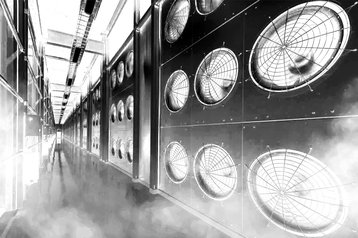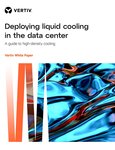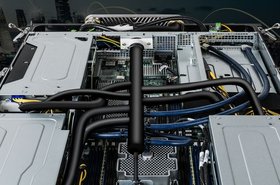ASHRAE TC 9.9 was established in 2002 as a response to the lack of a common set of environmental parameters that would ensure adequate reliability and performance (capacity) within reasonable cost constraints for data center design and construction. The Thermal Guidelines for Data Processing Environments, now in its 5th Edition, remains the foundation of the ASHRAE Datacom series (now ASHRAE TC 9.9 Datacom Encyclopedia).
When first established, the thermal guidelines represented the first comprehensive set of temperature and humidity conditions that linked the design of information technology equipment (ITE) and the data center. They provide guidance to data centers on operating the ITE for optimal performance, highest reliability, and lowest power consumption based on the best available information from IT manufacturers, and are updated periodically as new information is obtained.
While the Thermal Guidelines have become the de-facto standard for the environmental design and operation of ITE installed in a data center, they remain a guideline.
An owner or operator of any data center can choose not to use these environmental guidelines and develop their own. In fact, the Thermal Guidelines recognize this and offer a process that can be used to develop unique guidelines that help to operate data centers worldwide, and for business conditions that may permit improved total cost of ownership (TCO) through trade-offs between reliability and efficiency.
However, one challenge with the adoption of the Thermal Guidelines by the data center community has been that often important use criteria are ignored, resulting in the guidelines being seen as over-prescriptive and design-limiting in an inappropriate way.
This article (along with two future technical deep dive articles) is meant to complement two DCD Broadcasts:
- Ep 1 / The ASHRAE update: Setting the record straight on the thermal ranges
- Ep 2 / The end of overcooling - best practices for applying the ASHRAE Thermal Guidelines
Many factors need to be considered to determine the most appropriate data center operating envelope, given the business requirements.
The ASHRAE Thermal Guidelines offer two approaches:
Approach 1: Recommended and allowable environmental ranges
Recommended envelopes were chosen based on a number of inputs, the primary being reliability of ITE, power increases of ITE with higher ambient temperatures, acoustical impacts with higher ambient temperatures, and providing a buffer for short-term excursions into the allowable envelopes caused by events such as facility cooling failure.
Allowable envelopes are where IT manufacturers test their equipment to verify full operation and that it will function within those environmental boundaries. To enable the greatest latitude in use of all the classes, power and thermal management features may be triggered within the allowable range to ensure there are no thermal excursions outside the capability of the ITE under extreme load conditions.
- These envelopes were created for general use across all types of businesses and conditions.
- They provide standardized operating environments for different types of ITE.
- They should be used if a more detailed analysis is not being undertaken for the specific site to determine alternative envelopes (see Approach 2).
Approach 2: Total Cost of Ownership (TCO)
The Thermal Guidelines do not simply prescribe an environment. Any choice to operate outside of the thermal envelopes is a balance between the additional energy savings of the cooling system and the deleterious effects that may be created on the total cost of ownership (TCO); for example, total site energy use, reliability, acoustics, or performance. The Thermal Guidelines provide a TCO process to assess alternative envelopes for a specific data center environment. To apply the process detailed within the Thermal Guidelines book, the following factors will be key in one’s analysis:
- A methodology to account for competing factors (e.g., power consumption, IT reliability, data center airflow).
- General guidance on server metrics that assist data center operators in creating an operating envelope that matches their business values.
- Guidance on the impact of failure rate (i.e., x-factor).
This information is provided in the ASHRAE Thermal Guidelines, based on the best available information from IT manufacturers. If different environmental envelopes are used just be aware of the warranty requirements of the servers related to the environmental conditions.
Thermal guidelines in the age of AI
It is clear that increasing power requirements for artificial intelligence are rapidly driving the industry to need enhanced cooling. The 5th Edition of the ASHRAE Thermal Guidelines recognizes that liquid cooling provides a necessary path to support the increasing power density required of these applications, which exceed the ability to use air-cooling alone.
The ‘H’ air-cooling classes were introduced in the 5th Edition for scenarios where the facility is not designed for liquid cooling or cannot be easily adapted to liquid cooling. They were not introduced to slow down the progress of transitioning to liquid cooling.
In fact, the recently released TC 9.9 Datacom Encyclopedia introduces for the first time new ‘S’ classes for liquid cooling to help accelerate the ability for data centers to adopt liquid cooling.
Summary
The thermal design of ITE involves a delicate balance of ITE compute performance, ITE reliability, ITE cost, and ITE power consumption. In addition, the facility design must avoid increasing the overall power consumption of ITE and HVAC in the data center by creating an environment that results in increased energy consumption of the ITE and/or reduced compute per watt. Understanding the trade-offs between these objectives is critical to making energy savings decisions. The ASHRAE Thermal Guidelines for Data Processing Environments and the Recommended and Allowable envelopes provide a common set of design conditions for IT equipment manufacturers to design to.
- The Recommended and Allowable envelopes condition should be used if no bespoke analysis is undertaken.
- The ASHRAE Thermal Guidelines provide a method for evaluating alternative conditions, balancing the need for further energy saving than is possible in the standard environmental conditions with the different factors into TCO.
- High-density air-cooling classes are not intended to replace or delay liquid cooling solutions, but rather to allow computing in facilities that are only designed for air-cooling.
With increased emphasis on enhanced cooling required for higher server power densities and the ever-present focus on data center energy optimization, ASHRAE TC 9.9 will continue to engage those in the data center industry and IT manufacturers to provide the latest updates to our ASHRAE publications to aid the industry on operating the data centers in the most energy efficient and reliable fashion.
Roger Schmidt, ASHRAE TC 9.9 IT Subcommittee Chair and Mark Seymour, ASHRAE TC 9.9 Research Subcommittee Chair, contributed to this piece






